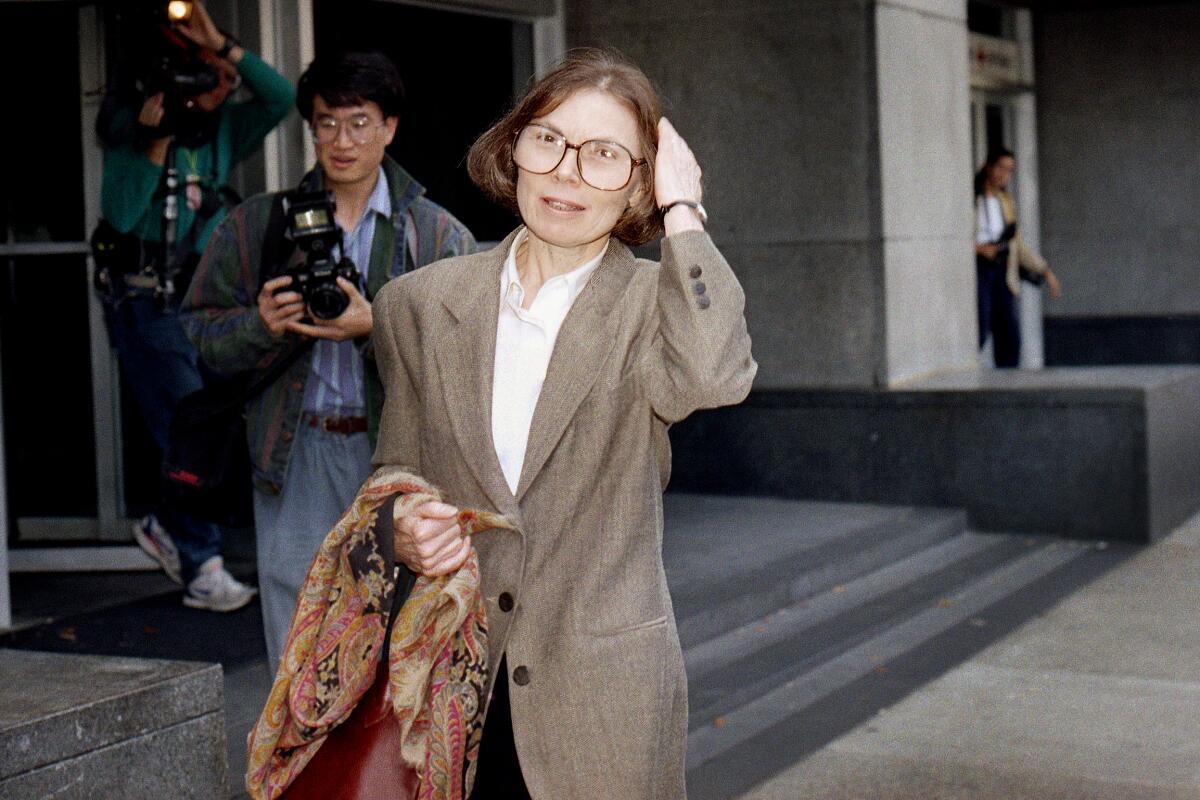Appreciation: Journalist Janet Malcolm’s work was a marvel, both chilling and provocative

One fall night in 1992, I was slumped at the cash register of an East Village bookstore, reading “The Journalist and the Murderer,” a chronicle of seduction and betrayal by Janet Malcolm, the peerless journalist who died Wednesday.
The book, wisely shorn of a subtitle, has a distinctive cover — pale yellow with block letters. One of the shop’s patrons asked me what I thought of it, and we agreed: It’s a marvel, both chilling and incendiary, and really nothing short of a book-length siege. Malcolm locks a vise on the reader from the first sentence — her pitiless assertion that journalism is “morally indefensible.” And you’re immobilized till the end when she turns her gimlet eye on the stupidity of journalistic subjects.
Like the young Aztec men and women selected for sacrifice, who lived in delightful ease and luxury until the appointed day when their hearts were to be carved from their chests, journalistic subjects know all too well what awaits them when the days of wine and roses — the days of the interviews — are over. And still they say yes when a journalist calls, and still they are astonished when they see the flash of the knife.
The bookstore patron, Rob Boynton, a journalist himself, eventually asked why I was working the nightshift at a 24-hour bookstore that seemed to specialize in Conspiracy Magazine for men and manuals on how to find love for women. When I stammered something about money, he mentioned an opening for a fact-checker at the New Yorker.
I took the A-train from Brooklyn to midtown the next day, and to my surprise, got the job. The only hitch was a shortage of cubicles, so my boss installed me in the windowless office of one of the staff writers who rarely came in: Janet Malcolm.
During the two or three times that Malcolm popped into her office, always gracious, to grab a book by Hannah Arendt or Susan Sontag, I never told her the story. Yes, I was starstruck. But the serendipity would have been too cute for her, or so I imagined; she seemed to prefer her stories tart. Her great gift was dismantling sentimental or melodramatic fairy tales, and what would happen if she suspected I wasn’t telling the whole truth about the bookstore night? I’d almost certainly spill my guts or otherwise disclose embarrassing secrets.
Shame is the fate of Malcolm’s interview subjects. In Malcolm’s 1997 book “Psychoanalysis: The Impossible Profession,”’ the pseudonymous Aaron Green drops his professional authority within minutes of meeting the writer and treats her to a florid display of neuroses. And while Jeffrey Masson in “In the Freud Archives” clearly considers himself the soul of charm, he comes across, in Malcolm’s observation, as a vain dilettante and world-historical jerk.
Unlike most contemporary journalists, who tend to see themselves as storytellers more than philosophers, Malcolm had a rigorous critical methodology and a vital theory of selfhood. Near the start of “The Impossible Profession,” her 1981 book, she introduces her conviction that “the most precious and inviolate of entities — personal relations — is actually a messy jangle of misapprehensions, at best an uneasy truce between powerful solitary fantasy systems.”
Philosophical consistency is not easy for journalists, especially for reporters who must get deep into particulars. But somehow Malcolm was, for the length of her career, true to her premise that relationships are determined largely by confusion and delusion. Her work was in exposing the misunderstandings and self-serving fantasies, to lay bare the richness of reality. In 1995, in an article about Bloomsbury called “A House of One’s Own,” she scoffs at the central piety of modernism — that history moves from “from social backwardness to social progress” — and shows passion less about human lives than about “the workshop where biographical narratives are manufactured.”
There were two narrative workshops she toured most scrupulously: the ones that created the trope of the long-suffering poet Sylvia Plath and the one that created Long Beach doctor Jeffrey MacDonald. In Malcolm’s telling, Plath, who died of suicide in 1963, and MacDonald, who is in prison for murdering his family, are far more complex than their biographers pretend. In “The Silent Woman” (about Plath) and “The Journalist and the Murderer” (about MacDonald), she argues that feminine suffering and masculine psychopathy are inadequate to the task of describing anyone, really. They had been forced on Plath and MacDonald by their fans and detractors, who had their own motives, sometimes pathological, for razing nuance.
At one point, Malcolm called herself the “fallen woman of journalism.” Indeed, some quarters tried to cancel her, mostly for spilling trade secrets about how journalists, especially the bestselling writer Joe McGinniss , got their subjects to trust them, only to julienne them in print. Malcolm was sued for defamation by the psychoanalyst Masson, who didn’t do much to reverse her portrait of him as a jerk when he acted with operatic indignation and then lost the case.
I’ve kept in touch with Rob from the bookstore over the decades, and right after we met he published a piece called “Who’s Afraid of Janet Malcolm?” — probably the best thing ever written about her. I emailed him the other day to fact-check this piece, as I had learned to do at the New Yorker in the job that sent me on a path to journalism. He corrected some errors in it and tested my memory on some of the richer details that I’d omitted from that first bookstore encounter. We had no reason to clear up anything, though, content with Malcolm’s implied blessing to leave the happy friendship “a jangle of misapprehensions, at best an uneasy truce between powerful solitary fantasy systems.”
Virginia Heffernan is a regular contributor to the Times Opinion section.
More to Read
Sign up for our Book Club newsletter
Get the latest news, events and more from the Los Angeles Times Book Club, and help us get L.A. reading and talking.
You may occasionally receive promotional content from the Los Angeles Times.






